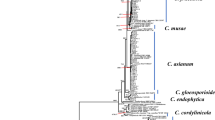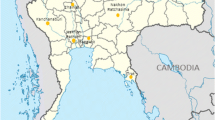Abstract
Mango is widely grown in Taiwan and anthracnose is one of the most important diseases of this crop. The aim of this study was to investigate Colletotrichum species associated with mango and the pathogenicity of these fungal species. From 2006 to 2017, mango tissue from 33 mango orchards were collected. Eighty-seven isolates associated with mango were analyzed preliminarily by comparing partial glyceraldehyde-3-phosphate dehydrogenase sequences. Four species belonging to C. gloeosporioides complex were preliminarily identified, namely C. asianum (68 isolates), C. fructicola (four isolates), C. siamense (eight isolates) and C. tropicale (two isolates). The other five isolates were identified as belonging to the C. acutatum complex. Ten isolates, belonging to different Colletotrichum species according to glyceraldehyde-3-phosphate dehydrogenase sequences prediction, were used for further morphology and multi-gene phylogenetic analysis. Five species were identified, namely C. asianum, C. fructicola, C. siamense, C. tropicale and C. scovillei. All five species showed pathogenicity on fruit, and C. asianum isolates C-1076 and C-1646 as well as C. siamense isolate C-526 caused larger lesions than the other isolates. On mango leaves, C. asianum, C. fructicola, C. siamense and C. scovillei isolates were pathogenic, while C. tropicale isolates, C-141 and C-303, failed to cause significant foliar lesions. In addition, C. siamense isolates C-526 and C-848 caused significantly larger lesions on leaves than other isolates. This study reports the identification and pathogenicity of Colletotrichum species related to mango anthracnose in Taiwan.



Similar content being viewed by others
References
Ann, P. J. (1995). The sexual stage (Glomerella cingulara) of Colletotrichum gloeosporioides from mango, and effect of temperature and light on its reproduction. Plant Pathology Bulletin, 4, 173–179.
Arauz, L. F. (2000). Mango anthracnose: Economic impact and current options for integrated management. Plant Disease, 84, 600–611.
Caires, N., Pinho, D., Souza, J., Silva, M., Lisboa, D., Pereira, O., & Furtado, G. (2014). First report of anthracnose on pepper fruit caused by Colletotrichum scovillei in Brazil. Plant Disease, 98, 1437. https://doi.org/10.1094/PDIS-04-14-0426-PDN.
Carbone, I., & Kohn, L. M. (1999). A method for designing primer sets for speciation studies in filamentous ascomycetes. Mycologia, 91, 553–556.
Cheng, B. P., Huang, Y. H., Song, X. B., Peng, A. T., Ling, J. F., & Chen, X. (2013). First report of Colletotrichum siamense causing leaf drop and fruit spot of Citrus reticulata Blanco cv. Shiyue Ju in China. Plant Diasease, 97, 1508.
Chung, P. C., Wu, H. Y., Ariyawansa, H. A., Tzean, S. S., & Chung, C. L. (2019). First report of anthracnose crown rot of strawberry caused by Colletotrichum siamense in Taiwan. Plant Disease. https://doi.org/10.1094/PDIS-12-18-2167-PDN.
Damm, U., Cannon, P. F., Woudenberg, J. H., & Crous, P. W. (2012). The Colletotrichum acutatum species complex. Studies in Mycology, 73, 37–113. https://doi.org/10.3114/sim0010.
Dodd, J. C., Prusky, D., & Jeffries, P. (1997). Fruit diseases. In R. E. Litz (Ed.), The Mango: Botany, Production and Uses (pp. 257–280). Slough: CAB international publication.
Freeman, S., Katan, T., & Shabi, E. (1998). Characterization of Colletotrichum species responsible for anthracnose diseases of various fruits. Plant Disease, 82, 596–605.
Fu, M., Crous, P. W., Bai, Q., Zhang, P. F., Xiang, J., Guo, Y. S., Zhao, F. F., Yang, M. M., Hong, N., Xu, W. X., & Wang, G. P. (2019). Colletotrichum species associated with anthracnose of Pyrus spp. in China. Persoonia, 42, 1–35.
Gardes, M., & Bruns, T. D. (1993). ITS primers with enhanced specificity for basidiomycetes – Application to the identification of mycorrhizae and rusts. Molecular Ecology, 2, 113–118.
Giblin, F. R., Tan, Y. P., Mitchell, R., Coates, L. M., Irwin, J. A. G., & Shivas, R. G. (2018). Colletotrichum species associated with pre- and post-harvest diseases of avocado and mango in eastern Australia. Australasian Plant Pathology, 47, 269–276.
Glass, N. L., & Donaldson, G. C. (1995). Development of primer sets designed for use with the PCR to amplify conserved genes from filamentous ascomycetes. Applied and Environmental Microbiology, 61, 1323–1330.
Jayasinghe, C. K., & Fernando, T. H. P. S. (2009). First report of Colletotrichum acutatum on Mangifera indica in Sri Lanka. Ceylon Journal of Science (Biological Sciences), 38, 31–34.
Krishnapillai, N., & Wilson Wijeratnam, R. S. (2014). First report of Colletotrichum asianum causing anthracnose on Willard mangoes in Sri Lanka. New Disease Reports, 29, 1.
Kumar, V. S., Nair, B. A., Nair, P. V. R., Annamalai, A., Jaishanker, R., Umamaheswaran, K., Sooraj, N. P., & Peethambaran, C. K. (2017). First report of Colletotrichum siamense causing anthracnose of cliff banana in India. Plant Disease, 101, 390.
Larkin, M. A., Blackshields, G., Brown, N. P., Chenna, R., & McGettigan, P. A. (2007). Clustal W and Clustal X v. 2.0. Bioinformatics, 23, 2947–2948.
Latiffah, Z., Nurul, Z. J., Suzianti, I. V., & Intan, S. M. A. (2015). Molecular characterization of Colletotrichum isolates associated with anthracnose of mango fruit. Sains Malaysiana, 44, 651–656.
Lima, N. B., de A. batista, M. V., De Morais, M. A., Barbosa, M. A. G., Michereff, S. J., Hyde, K. D., & Câmara, M. P. S. (2013). Five Colletotrichum species are responsible for mango anthracnose in northeastern Brazil. Fungal Diversity, 61(1), 75–88.
Lin, W. L. (2018). Phylogenetic species and biological characteristics of mango anthracnose pathogens in Taiwan. M.S. thesis. National Chung Hsing University.
Lou, P. S., Huang, Y. J., Chung, W. C., Cheng, A. S., & Chung, W. H. (2010). Application of PCR-RFLP in detecting benzimidazoles-resistant isolates of Colletotrichum gloeoeporioides from mango in Tainan area. Plant Pathology Bulletin, 19, 255–260.
Meetum, P., Leksomboon, C., & Kanjanamaneesathian, M. (2015). First report of Colletotrichum aenigma and C. siamense, the causal agents of anthracnose disease of dragon fruit in Thailand. Journal of Plant Pathology, 97, 402.
Mo, J., Zhao, G., Li, Q., Solangi, G. S., Tang, L., Guo, T., Huang, S., & Hsiang, T. (2018). Identification and characterization of Colletotrichum species associated with mango anthracnose in Guangxi, China. Plant Disease, 102, 1283–1289.
Ni, H. F., Huang, C. W., Wu, C. J., Yang, H. R., Lin, C. Y., Chang, J. Y., & Chang, J. W. (2017). First report of pepper spot disease of lychee caused by Colletotrichum siamense in Taiwan. Journal of Plant Pathology, 99, 808.
O’Donnell, K., & Cigelnik, E. (1997). Two divergent intragenomic rDNA ITS2 types within a monophyletic lineage of the fungus Fusarium are nonorthologous. Molecular Phylogenetics and Evolution, 7, 103–116.
Oliveira, S. A. S., Bragança, C. A. D., & Silva, L. L. (2019). First report of Colletotrichum tropicale causing anthracnose on the wild cassava species Manihot dichotoma and M. epruinosa in Brazil. Plant Disease, 100, 2171.
Phoulivong, S., Mckenzie, E., & Hyde, K. D. (2012). Cross infection of Colletotrichum species: A case study with tropical fruits. Current Research in Environmental & Applied Mycology, 2, 99–11.
Posada, D. (2008). jModelTest: Phylogenetic model averaging. Molecular Biology and Evolution, 25, 1253–1256.
Qin, L. P., Yu, G. M., Zhang, Y., Su, Q., Nong, Q., Huang, S. L., & Xie, L. (2019). First report of anthracnose of Mangifera indica caused by Colletotrichum scovillei in China. Plant Disease. https://doi.org/10.1094/PDIS-11-18-1980-PDN.
Rambaut, A. & Drummond, A. J. (2007). Tracer v. 1.4, Available from http://beast.bio.ed.ac.uk/Tracer
Ronquist, F., Teslenko, M., van der Mark, P., Ayres, D., & Darling, A. (2012). MrBayes v. 3.2: Efficient Bayesian phylogenetic inference and model choice across a large model space. Systematic Biology, 61, 539–542.
Sharma, G., Kumar, N., Weir, B. S., Hyde, K. D., & Shenoy, B. D. (2013). The ApMat marker can resolve Colletotrichum species: A case study with Mangifera indica. Fungal Diversity, 61(1), 117–138.
Sharma, G., Gryzenhout, M., Hyde, K. D., Pinnaka, K., & Shenoy, D. (2015). First report of Colletotrichum asianum causing mango anthracnose in South Africa. Plant Disease, 99, 725.
Templeton, M. D., Rikkerink, E. H. A., Solon, S. L., & Crowhurst, R. N. (1992). Cloning and molecular characterization of the glyceraldehyde-3-phosphate dehydrogenase encoding gene and cDNA from the plant pathogenic fungus Glomerella cingulata. Gene, 122, 225–230.
Vaidya, G., Lohman, D. J., & Meier, R. (2011). SequenceMatrix: Concatenation software for the fast assembly of multi-gene datasets with character set and codon information. Cladistics, 27, 171–180.
Weir, B. S., Johnston, P. R., & Damm, U. (2012). The Colletotrichum gloeosporioides species complex. Studies in Mycology, 73, 115–180. https://doi.org/10.3114/sim0011.
Weng, F. Y., & Chuang, T. Y. (1995). Grouping of mango anthracnose fungus in Taiwan. Plant Protection Bulletin, 37, 295–309.
White, T. J., Bruns, T., Lee, S., & Taylor, J. W. (1990). Amplification and direct sequencing of fungal ribosomal RNA genes for phylogenetics. In M. A. Innis, D. H. Gelfand, J. J. Sninsky, & T. J. White (Eds.), PCR Protocols: A Guide to Methods and Applications (pp. 315–322). New York: Academic Press.
Zhao, W., Wang, T., Chen, Q. Q., Chi, Y. K., Swe, T. M., & Qi, R. D. (2016). First report of Colletotrichum scovillei causing anthracnose fruit rot on pepper in Anhui Province, China. Plant Disease, 100, 2168.
Author information
Authors and Affiliations
Corresponding author
Ethics declarations
Conflict of interest
There are no potential conflicts of interest.
This research is not involving human participants and/or animals
Therefore, there is no informed consent needed.
Rights and permissions
About this article
Cite this article
Wu, CJ., Chen, HK. & Ni, HF. Identification and characterization of Colletotrichum species associated with mango anthracnose in Taiwan. Eur J Plant Pathol 157, 1–15 (2020). https://doi.org/10.1007/s10658-020-01964-4
Accepted:
Published:
Issue Date:
DOI: https://doi.org/10.1007/s10658-020-01964-4




